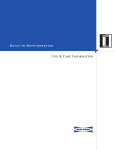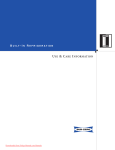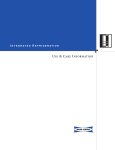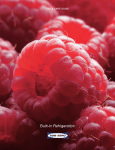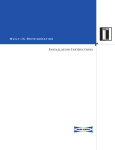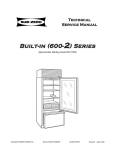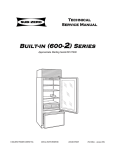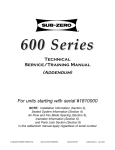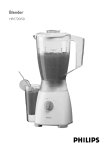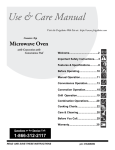Download Use & Care Guide - Villa Villekulla
Transcript
600 Use & Care Guide SERIES ® 600 SERIES ® I NTRODUCING THE 600 SERIES Creative Solutions to Your Home Food Needs Thank you for purchasing your new Sub-Zero 600 Series unit. With Sub-Zero, you can rely on a 50 year tradition of quality and reliability. The 600 Series brings together the latest and finest features in home refrigeration to give you the freshest, best tasting food in the world. Your Sub-Zero 600 Series unit is protected by a warranty that is one of the finest in the industry. Take a moment to read the warranty statement at the rear of this book, and refer to it should service become necessary. Table of Contents This Use & Care Guide will answer most of your questions about the features, operation and maintenance of your 600 Series unit. If you have questions that are not addressed here, call 800-222-7820, or e-mail us at [email protected]. Introducing the 600 Series . . . . . . . . . . . . . . . . . 3 600 Series Models Models 601R and 601RG . . 4 Model 601F . . . . . . . . . . . . 5 Models 611 and 611G . . . . 6 Models 650 and 650G . . . . 7 Models 561 and 642 . . . . . 8 Model 632 . . . . . . . . . . . . . 9 Models 680 and 690 . . . . 10 Features of the 600 Series . . . . . . . . . . . 11-12 Using Your Sub-Zero Caring For Your Sub-Zero Cleaning . . . . . . . . . . . 21-22 Lighting Information . . . . . . . . . . . 23 Troubleshooting Guide . . . . . . . . . . . . . . . 24-26 Keeping Food at its Best Keeping Food Fresh . . . . 27 Keeping Food Safe to Eat . . . . . . . . . 28-30 Food Storage Suggestions . . . . . . . . 31-37 Service Information . . . . . 38 Warranty . . . . . . . . . . . . . . 39 The Electronic Control System . . . . . . 13-14 Refrigerator Storage . . 14-15 Freezer Storage . . . . . . 16-17 Models 680 and 690 Ice and Water Dispensing . . . . . . . . . 17-19 Vacation Time . . . . . . . . . 19 Operations . . . . . . . . . . . . 20 3 6 00 Series Models Model 601R Model 601RG All Refrigerator All Refrigerator with Glass Door Lighted Electronic Control Panel Lighted Electronic Control Panel Model and Serial Number Plate Model and Serial Number Plate Triple Pane UV Resistant Low-Energy Glass Door Adjustable Dairy Compartment Adjustable Drip-Proof Glass Shelves Adjustable Drip-Proof Glass Shelves 601R Adjustable Door Shelves Adjustable Roll-Out Utility Basket Egg Container Egg Container High Humidity Compartment High Humidity Compartment Four-Sided Magnetic Gaskets Hermetically Sealed Refrigeration Units Removable Kickplate 4 Front Venting allows unit to be completely built in Door Closers Hermetically Sealed Refrigeration Units Removable Kickplate Four-Sided Magnetic Gaskets Front Venting allows unit to be completely built in Door Closers Model 601F All Freezer Lighted Electronic Control Panel Model and Serial Number Plate Adjustable Door Shelves Adjustable Wire Shelves 601F Automatic Ice Maker Pull-Out Ice Container Roll-Out Storage Baskets Hermetically Sealed Refrigeration Units Removable Kickplate Four-Sided Magnetic Gaskets Front Venting allows unit to be completely built in Door Closers 5 6 00 Series Models Model 611 Model 611G Over/Under Refrigerator/Freezer Over/Under Refrigerator/Freezer with Glass Door Front Venting allows unit to be completely built in Lighted Electronic Control Panel Front Venting allows unit to be completely built in Hermetically Sealed Refrigeration Units Lighted Electronic Control Panel Hermetically Sealed Refrigeration Units Model and Serial Number Plate Model and Serial Number Plate 611G 611 Adjustable Drip-Proof Glass Shelves Adjustable Drip-Proof Glass Shelves Adjustable Dairy Compartment Adjustable RollOut Utility Basket Triple Pane UV Resistant Low-Energy Glass Door Egg Container Egg Container High Humidity Compartment High Humidity Compartment Automatic Ice Maker Adjustable Door Shelves Two Tier Wire Storage Baskets Four-Sided Magnetic Gaskets Automatic Ice Maker Two Tier Wire Storage Baskets Four-Sided Magnetic Gaskets Door Closers Door Closers Removable Kickplate 6 Roll-Out Freezer Drawer Removable Kickplate Roll-Out Freezer Drawer Model 650 Model 650G Over/Under Refrigerator/Freezer Over/Under Refrigerator/Freezer with Glass Door Front Venting allows unit to be completely built in Lighted Electronic Control Panel Front Venting allows unit to be completely built in Hermetically Sealed Refrigeration Units Lighted Electronic Control Panel Hermetically Sealed Refrigeration Units Model and Serial Number Plate Model and Serial Number Plate 650 650G Adjustable Drip-Proof Glass Shelves Adjustable Drip-Proof Glass Shelves Adjustable Dairy Compartment Adjustable RollOut Utility Basket Triple Pane UV Resistant Low-Energy Glass Door Egg Container Egg Container High Humidity Compartment High Humidity Compartment Automatic Ice Maker Adjustable Door Shelves Two Tier Wire Storage Baskets Four-Sided Magnetic Gaskets Automatic Ice Maker Two Tier Wire Storage Baskets Four-Sided Magnetic Gaskets Door Closers Removable Kickplate Roll-Out Freezer Drawer Door Closers Removable Kickplate Roll-Out Freezer Drawer 7 6 00 Series Models Model 561 Model 642 Side by Side Refrigerator/Freezer Side by Side Refrigerator/Freezer Model and Serial Number Plate Front Venting allows unit to be completely built in Front Venting allows unit to be completely built in Hermetically Sealed Refrigeration Units Model and Serial Number Plate Hermetically Sealed Refrigeration Units Lighted Refrigerator Control 561 Lighted Electronic Control Panel 642 561 642 Adjustable Wire Shelves Adjustable Drip-Proof Glass Shelves Lighted Freezer Control Egg Tray Adjustable Wire Shelves Adjustable Roll-Out Utility Basket Automatic Ice Maker Adjustable Dairy Compartment Automatic Ice Maker Adjustable Drip-Proof Glass Shelves Ice Storage Drawer Adjustable Roll-Out Utility Basket Ice Storage Drawer Egg Tray Adjustable Dairy Compartment Adjustable Door Shelves Adjustable Door Shelves Crisper Drawers High Humidity Compartment Four-Sided Magnetic Gaskets Removable Kickplate 8 Roll-Out Freezer Baskets Door Closers Four-Sided Magnetic Gaskets Removable Kickplate Roll-Out Freezer Baskets Door Closers Model 632 Side by Side Refrigerator/Freezer Front Venting allows unit to be completely built in Hermetically Sealed Refrigeration Units Model and Serial Number Plate Lighted Electronic Control Panel 632 632 Adjustable Dairy Compartment Adjustable Wire Shelves Adjustable Roll-Out Utility Basket Automatic Ice Maker Adjustable Drip-Proof Glass Shelves Ice Storage Drawer Egg Tray Adjustable Door Shelves High Humidity Compartment Four-Sided Magnetic Gaskets Removable Kickplate Roll-Out Freezer Baskets Door Closers 9 6 00 Series Models Model 680 Model 690 Side by Side with Ice & Water Dispensing Side by Side with Ice & Water Dispensing Automatic Ice Maker Front Venting allows unit to be completely built in Model and Serial Number Plate Automatic Ice Maker Hermetically Sealed Refrigeration Units Front Venting allows unit to be completely built in Hermetically Sealed Refrigeration Units Model and Serial Number Plate Lighted Electronic Control Panel Lighted Electronic Control Panel 680 690 680 690 Adjustable Dairy Compartment Adjustable Dairy Compartment Freezer Utility Rack Adjustable DripProof Glass Shelves Adjustable Wire Shelves Bulk Ice Dispenser Adjustable Door Shelves Adjustable Roll-Out Utility Basket Adjustable DripProof Glass Shelves Freezer Utility Rack Bulk Ice Dispenser Adjustable Wire Shelves Adjustable Roll-Out Utility Basket Adjustable Door Shelves 10 Roll-Out Freezer Baskets Adjustable Door Shelves Egg Tray Egg Tray Four-Sided Magnetic Gaskets High Humidity Compartment Removable Kickplate Adjustable Door Shelves Door Closers High Humidity Compartment Removable Kickplate Roll-Out Freezer Baskets Four-Sided Magnetic Gaskets Door Closers F eatures of the 600 series 600 Series Features Sub-Zero’s Dual Refrigeration Assures Maximum Freshness... The 600 Series continues the Sub-Zero tradition of superior quality and reliability. Sub-Zero pioneered the development of our exclusive dual refrigeration system, giving you optimum fresh and freezer food storage in ideal self-contained compartments. Both refrigerator and freezer maintain accurate, consistent temperatures. Dual refrigeration keeps your food fresh longer than any other system available. With dual refrigeration, the freezer maintains a constant temperature within one degree of the temperature you set within our range of -5°F (-21˚C) to +5°F (-15˚C), without unwanted moisture and odor from the refrigerator. Similarly, you can adjust the refrigerator temperature within a range of 34°F (1˚C) to 45°F (7˚C), for proper humidity levels tailored for longer food life expectancy. The dual refrigeration system also means there is no transfer of fresh food odors to frozen food or ice. And the Sub-Zero 600 Series system does not freeze the moisture out of the air in the fresh food compartment. Sub-Zero dual refrigeration is also more energy efficient than old-fashioned single refrigeration systems. When the refrigerator is used frequently during the day it does not require the freezer to circulate its very cold, dry air to the refrigerator. Instead, the refrigerator uses moist air to keep fresh foods fresh and energy use minimal. Sub-Zero’s design, beauty and quality are reflected in the broad range of standard features that put Sub-Zero in a class by itself. Whether your customer prefers stainless steel, traditional framed, overlay design or a glass door unit, Sub-Zero’s 600 Series has the most design options to complement your installation. The custom-design appearance of the Sub-Zero 600 Series gives it unique consumer appeal and gives you options no other line offers. • Overlay models blend seamlessly into your overall room design and complement surrounding cabinetry. • Classic stainless steel, or the premium finishes of platinum or carbon stainless steel models feature new wrapped doors, 1" (25 mm) diameter stainless steel handles and stainless steel grille designed specifically to enhance the aesthetics of the professional look of kitchens today. • Classic framed models – the look that made Sub-Zero famous – now feature an improved grille design, innovative handle design and elegant hinges. • Glass door models add a contemporary look that is quite unique and innovative, with subdued interior lighting. 11 F eatures of the 600 series 600 Series Features • The Models 601RG, 611G and 650G offer a unique feature – a glass door. These units each come in stainless steel, overlay and framed design and meet stringent energy requirements. • All 600 Series combination refrigerator/freezer units have the exclusive Sub-Zero dual refrigeration system, which ensures the freshest food and energy efficiency at the same time. You have precise independent control of the refrigerator and freezer compartments. • High-humidity compartment is large and deep with smooth sides for easy cleaning. The compartment features removable dividers, with the exception of Models 561, 642 and 680. 12 • Controls are up front and easy to use. They give you digital readings for quick, easy-to-read reference. Up-front controls also keep you informed about the operation of the unit on a continuous basis. • A door alarm will let you know with an audible beeping if your refrigerator or freezer door is left ajar. (Not available on the Model 561). • Bright lighting spreads even illumination throughout the compartment and conceals the source. • Sub-Zero’s added a microprocessor to give you better control, automatic defrosting that senses, then adapts to your use patterns, and a service indicator light. Our microprocessor continuously monitors each compartment and should a problem arise, the processor will turn on the SERVICE indicator in your display panel. (Not available on the Model 561). • Cantilevered shelves make repositioning quick and easy. They’re easy to clean and drip-proof. They are steel reinforced to provide durability and reliability. • Dairy compartment is adjustable, with easy, one-door access, compartment dividers and a clean design. The dairy shelf is magnetically sealed to maintain freshness. • Ice maker provides highquality, crescent-shaped ice that won’t stick to the side of the glass. • Shallow-depth design means access is easy to any area of the refrigerator. • In-door shelves are all adjustable for complete flexibility. • Magnetic gaskets around all doors give extra tight seals. • Our solid-core doors improve insulation and structural integrity. • Solid, adjustable kickplate gives a true built-in look, and conforms to American Institute of Architects standards. U sing your sub-Zero The Electronic Control System The Electronic Control System of your Sub-Zero 600 series unit monitors and accurately displays compartment temperatures within one degree of your pre-set temperature. It also monitors operation of the unit and lets you know if there’s a problem. You’ll find the Control Center located in the refrigerator section of all models except Model 601F, where it is in the freezer compartment. Freezer Control REFRIGERATOR COLDER WARMER FREEZER Ice On/Off WARMER ICE ON/OFF ON/OFF Unit On/Off Refrigerator Control COLDER UNIT ON/OFF BULK ICE DISPENSER Bell On/Off Bulk Ice Dispenser Key Models 680 & 690 control center Temperature Control FREEZER COLDER WARMER COLDER WARMER REFRIGERAT OR ICE ON/OFF ON/OFF UNIT ON/OFF 632 Ice On/Off Freezer Control Bell On/Off Refrigerator Control Electronic control center Unit On/Off Your new refrigerator/freezer was thoroughly inspected and tested before it was shipped from the Sub-Zero factory. Temperatures are preset at 38°F (3˚C) in the refrigerator section and 0°F (-18˚C) in the freezer section. There are two sets of WARMER and COLDER key pads, one for the refrigerator and the other for the freezer. To adjust the temperature in either compartment, depress the WARMER or COLDER keys on the Control Center. NOTE: The temperature ranges are -5°F (-21˚C) to +5°F (-15˚C) in the freezer section, and 34°F (1˚C) to 45°F (7˚C) in the refrigerator section. It is normal for temperatures to fluctuate slightly, depending on external influences such as: an open door, the degree of humidity and room temperature. NOTE: Always allow 24 hours for the refrigerator to reach the temperature you set. Alarm On/Off All 600 Series units, with the exception of the Model 561, feature an ALARM ON/OFF button that will give you an audible beeping sound if the door is left ajar. The alarm will sound for 30 seconds. It can be disarmed for cleaning or resupplying your refrigerator by depressing the button. When the alarm is activated, a bell symbol will be visible in the display. Power On/Off All 600 Series units feature a UNIT ON/OFF key on the Control Center. This key will turn off all electrical power. When the power is off, the OFF indicator light will be visible on the display panel. This UNIT ON/OFF key means you don’t have to shut off power at the circuit breaker or wall receptacle. The key can be used during service or extended vacations. 13 U sing your sub-Zero Refrigerator Storage Ice Maker On/Off All 600 Series units feature an ICE ON/OFF key on the Control Center. This key switches the power to the ice maker system on or off. When the ice maker system is on, the ICE indicator light will be illuminated in the display. Use the ICE ON/OFF key to shut down the ice maker during extended vacations. Lights and Ice Maker On/Off (Sabbath Mode) All 600 Series units feature the Sabbath Mode. This is for certain religious observances where the lights and ice maker function need to be turned off. To initiate Sabbath Mode, while the unit is "on" press the UNIT ON/OFF key so that OFF is visible in the display. Your unit will be off. Then press and hold the UNIT ON/OFF key for 10 seconds. 14 This will turn the unit back on and will disable the lights and ice maker. To return the unit to normal operating conditions, press and release the UNIT ON/OFF key. Visual Display During Servicing or Condenser Cleaning The Control Center monitors compartment and component temperatures as well as the ice maker system. If there is a temperature or ice maker problem, you’ll be alerted by a flashing SERVICE indicator light. This same SERVICE light will also flash if the condenser needs cleaning. Before calling for service, please check and see if your condenser area needs cleaning. Refer to Condenser Cleaning on page 21. High Humidity Drawer Adjustable Shelves To remove your high humidity drawer, pull open until the drawer stops. Now raise the front of the drawer and pull it out. To reinstall the drawer, insert it into the tracks with the front end raised. Some units also have other storage drawers, which can be removed in a similar manner. Be sure to read and understand the following instructions before removing or adjusting shelves. The process is relatively simple if you understand the steps involved in advance. To remove or adjust shelves, first tilt the shelf up at the front, then lift it up and out of the tracks on the rear wall of the refrigerator. If the door opens only to 90°, lift and tilt the right end of the shelf up in order to clear the door shelves. Always be careful in handling glass shelves to prevent breaking or scratching the interior. High humidity drawer To replace a shelf, insert it in the tracks at the rear of the refrigerator with the front of the shelf raised slightly. As you push the shelf in, lower the front of the shelf until it locks into position. Adjustable glass shelves A gallon door shelf is available upon request for Models 601R, 611, 650, 642, 632, 680 and 690. This shelf must be positioned properly to allow for proper door closure. Utility Basket The utility basket rolls in and out so that you can get to small containers and food items easily. To remove the basket, pull it out, lift up on the front, then out. If the door opens only to 90°, you’ll need to remove the entire basket and shelf as one unit. To do this, place one hand palm up under the roll out utility basket and lift it out of the support track. Tilt the right end upward and remove it, clearing the door shelves. To replace the basket, insert the roller into its tracks with the front of the basket raised, and push in. (Available as an option on Models 601RG, 611G and 650G). Refrigerator utility basket Door Shelves and Dairy Compartment The door shelves and dairy compartment are adjustable within the guides of the door liner. To remove shelves or dairy compartment, lift straight up and out from the bottom. To reinstall the shelves, push them down into the guides. Door shelf and dairy compartment 15 U sing your sub-Zero Freezer Storage If the basket sticks during removal, lift it up to disengage the rollers. To reinstall the basket, reverse the procedure. Freezer Drawer Removal Models 611, 611G, 650 and 650G For safety, the freezer drawer stops before coming all the way out of the unit. To remove it, lift up evenly on each side of the drawer while holding the top basket in place, and pull out. The drawer and basket will come out together. IMPORTANT NOTE: Be sure to unload the drawer before removing it. CAUTION As you remove the drawer, be very careful to keep your feet clear. 16 IMPORTANT NOTE: Unload the freezer baskets before removing. Ice Bucket Removal Models 611, 611G, 650 and 650G To remove the ice bucket, pull the freezer drawer or basket out until it stops and lift the ice bucket out. Ice Bucket Removal Models 561, 642 and 632 Models 611, 611G, 650 & 650G freezer drawer Freezer Basket Removal Models 601F, 642 and 632 First, unload the freezer basket. To remove the basket, pull it out until it stops. Raise the front of the basket and pull it out. If the door is limited to a 90° opening, pivot the basket away from the door and tilt it up sharply as soon as the rollers leave the tracks. Freezer basket removal To remove the ice bucket, pull it out until it stops, and lift the back of the bucket up to clear the carrier assembly. Next, lift the ice bucket out. If the door is limited to a 90° opening, repeat the procedure, but when lifting the ice bucket out, pivot the right side of the bucket toward you and out. This will allow the ice bucket to clear the door. Models 680 and 690 Ice and Water Dispensing Freezer Utility Rack Models 680 and 690 The freezer utility rack is specifically designed to accommodate and hold freezer juice containers. To remove the rack, lift up and pull out at the bottom with one hand, then support the top with your other hand. Ice Bucket Removal Models 680 and 690 To remove the ice bucket of Model 680 or 690, you must first remove the freezer utility rack. Then, lift up on the ice bucket handle and pull out, supporting the bottom of the ice bucket with one hand. Models 680 & 690 ice bucket Ice Maker Operation The ice maker in your Sub-Zero freezer is fully automatic and has been tested at the factory. To start making ice, activate the ICE ON/OFF key on the Control Center. On Models 601F, 611, 611G, 650 and 650G, the ice maker system will shut off if the ice bucket is not in place. Ice Production Ice and Water Dispenser The ice maker is designed to produce enough ice for normal family use. The timing of ice making cycles will vary depending on load conditions, door openings and room temperature. On average, you can expect eight cubes of ice every 2 to 2-1/2 hours. Your Model 680 or 690 automatic ice and water dispenser gives you both ice and chilled water without having to open doors. To operate the ice dispenser, hold the ice dispenser key down until you’ve got the ice you need. After initial ice maker start-up, discard the first few batches of ice – they may be discolored by the new system plumbing. The ice maker operates on water pressure of 20 to 100 psi. In some cases, a reverse osmosis water filter system may not be able to maintain the minimum pressure. If ice is not used regularly it tends to fuse together. To avoid this, empty and replace the ice in the container as needed. The ice dispenser will deliver ice when you 1) insert a glass back into the glasswell and push the ice dispenser key; or 2) open the refrigerator door and place an ice container underneath the ice dispenser chute, then press the bulk ice dispenser key on the chute housing. See Models 680 & 690 control center, page 13. 17 U sing your sub-Zero CAUTION Use a sturdy glass to catch ice crescents. Fragile glasses can break. Also, limit ice dispenser operation to eight minutes or less, to avoid damaging the equipment. Water Dispensing Key ICE WATER LIGHT Light Key Light Bulb Location Ice Dispensing Key Dispenser Spill Tray Models 680 & 690 glasswell 18 Ice Dispenser Operating Tips • If there’s no ice, check to make sure the ice maker system is turned on and that the ICE indicator light is on. • Make sure there’s a supply of ice in the ice bucket. See Ice Bucket Removal, page 17. • Make sure the ice bucket is all the way in and engaging the auger motor at the back of the bucket. If the ice bucket is not all the way back, push on the bucket and ice dispenser switch at the same time. • Make sure the freezer utility rack is properly installed, to make sure the ice bucket is properly positioned. See Freezer Utility Rack, page 17. • Press the ice dispenser key. If you do not hear auger motor noise, wait five minutes, then try again. If you do not hear auger noise after the second try, call your local Factory Authorized Service Center. • If the ice dispenser is not used for a long period, the ice may fuse together. To avoid this, empty the ice bucket as needed. To operate the water dispenser, press the water dispenser key pad continuously until your container is filled. The key is located on the refrigerator door glasswell. The first time you use the water dispenser, purge the water system and storage tank for three minutes. This will clear out any air in the system, along with foreign material in the new plumbing connection. Initially, for water to dispenser properly, the water dispense key pad must be depressed and held until water flows from the dispenser. You may have to hold the key for 60 seconds for the water to fill the internal reservoir tank. Vacation Time IMPORTANT NOTE: The chilled water reservoir tank is mounted inside the refrigerator section. It will take several hours to chill the water to the refrigerator temperature during the original fill or after a lot of water is used. CAUTION Limit water dispenser operation to eight minutes or less, to avoid damaging the equipment. Light Bulb and Light Key for Dispenser The door dispenser LIGHT key is located on the bottom left corner of the Control Center, in the ice and water dispenser glasswell. Press the LIGHT key to turn the dispenser light on and off. In the OFF mode, the light will turn on when either the ICE or WATER key is pressed, and remain on for five seconds after either key is released. The light bulb can be easily replaced with a seven watt appliance bulb. CAUTION Shut off power at the control panel before changing light bulbs. Wear protective gloves when handling bulbs. Dispenser Spill Tray A spill tray at the bottom of the ice and water dispenser will catch and evaporate small spills. Because there is no drain in this area, do not pour water into the spill tray. To clean the area, remove the spill tray grid by pressing the front left corner of the grid and lifting it out. For extended vacations, shut off power to the unit. Empty the unit and block the doors open slightly. A 1" (25 mm) space will let fresh air in to keep the interior dry and fresh smelling. For short vacations, remove all perishable items. Shut off the ice maker and empty the ice bucket. Do not change the control settings. If the unit is put into service temporarily and later shut off, block the doors open to allow fresh air to circulate inside the compartment. Be sure to shut off power to the unit. If your religious observances (Sabbath mode) require turning off the lights and ice maker, refer to the Electronic Control System on page 14. CAUTION Moisture buildup during even the shortest amount of running time could attack the metal. 19 U sing your sub-Zero Operations Door Closing Models 601R, 601RG, 601F, 561, 642, 632, 680 and 690 Your refrigerator and freezer doors have spring-loaded closure mechanisms. As the doors are closed, the door closure engages to help close and seal the doors. A 90° door stop is available through your Sub-Zero dealer. Door and Drawer Closing Models 611, 611G, 650 and 650G Your refrigerator door has a door closing cam to help in closing the door. With the door opened to about 120° the cam will hold in the open position if the door is stopped. As you close the door, the cam will take over at about 15° to help close the door. 20 Your freezer drawer has a selfclosing mechanism. The incline, built into roller assemblies on the drawer, uses gravity to assist in closing the drawer. If your Series 600 unit is positioned in a corner, you may want to install an optional door stop kit which limits door opening to 90°. This door stop is provided with each Model 611, 611G, 650 and 650G, and is shipped in a plastic bag in the grille area. Condenser Fan Motor Operation All 600 Series models have a fan behind the grille to cool the compressor area. This fan runs with either compressor. Automatic Defrost For convenience, your Sub-Zero unit is equipped with an automatic defrost system. The refrigerator section will defrost during each off cycle of the refrigerator compressor. The freezer section is controlled by an energy-saving Adaptive Defrost system, which defrosts as needed. (Not available on the Model 561). Sounds You may hear some noises in the normal operation of the unit. Surrounding acoustics like walls, floors and cabinets may affect the sound of your unit. For example, a gurgling or running water sound is probably refrigerant circulating through the tubing. In Models 680 and 690, the ice dispenser valve inside the refrigerator door snaps closed five seconds after either the water or ice dispenser key is released. During the ice maker cycle you may hear the sound of ice dropping into the container or the solenoid valve operating while refilling the ice maker with water. During the freezer defrost you may hear crackling and/or sizzling as the heat from the defrost element clears the frost from the freezer coil and water runs into the water pan. While the compressors are in operation you may hear a slight hum. During the startup and shutdown of the compressor, you may feel vibration for a few seconds. Some of these noises may be enhanced when the units door(s) are open. C aring for your sub-Zero Cleaning Exterior Cleaning To clean the exterior of a classic or platinum stainless steel model, use a soft, non-abrasive stainless steel cleaner like Signature Polish and apply with a soft lint-free cloth. Carbon stainless steel can be cleaned with mild soap and water. To bring out the natural luster of all three finishes, lightly wipe the surface with a waterdampened microfiber cloth, followed with a dry microfiber cloth. All work should follow the grain direction of the finish. Better results are obtained by keeping the cloth in continuous contact with the metal. CAUTION Under no circumstances should you use a metallic or highly abrasive cleaner or cloth, as this will remove the carbon finish. Signature Polish is available from Signature Limited Laboratory, P.O. Box 13436, Dayton, Ohio 45413-0436; 877-376-5474. Interior Cleaning Condenser Cleaning To clean interior surfaces and removable parts, wash with a mild solution of soap and lukewarm water with a little baking soda. Do not use vinegar. Rinse and dry thoroughly. Avoid getting water on lights, control display panel and Control Center. Clean the condenser area every three to six months. In all 600 Series models, the condenser is located behind the grille. First, remove the grille. To clean the glasswell of Model 680 or 690, use a mild solution of soap and water with a little baking soda. Wipe up spills after removing the dispenser spill grid. CAUTION Do not submerge or pour hot water over cold glass shelves. CAUTION Before cleaning your unit, shut the electricity off at the control center. When you clean the condenser, wear gloves to avoid injury from the sharp condenser fins. Use a soft bristle brush and vacuum to remove dust and lint from the condenser (radiator). To remove a standard louvered grille, first remove the grille screws. NOTE: Grille screws are accessed with door(s) open. Tilt the grille forward at the top and release the springs from behind the grille, then lift it off. To remove the grille for Models 601R, 601RG and 601F (framed and overlay), remove the two black screws in the lowest louver in the grille. Tilt the bottom of the grille out and away. It will release from the top of the grille. 21 C aring for your sub-Zero Cleaning Combination Units Models 611, 611G, 650, 650G, 642, 632, 680 and 690 Grille Springs Louvered grille removal Models 601R, 601RG & 601F (framed and overlay) grille removal The 601RG stainless grille is removed in a similar fashion as the panel grille noted here. To remove a panel grille, lift up, then pull out at the bottom and down to release from its mounting bracket. Failure to clean the condenser could result in temperature loss or mechanical failure or damage. Ice crescents may occasionally become lodged in the ice chute of the Model 680 or 690. The ice chute is a clear plastic housing that directs ice from the freezer ice bucket to the door ice dispenser. To remove these obstructions, first remove the screw in the lower left corner of the side panel, then hold the bottom of the side panel and push rearward, then pull out. Once the panel is removed, the ice chute will be visible. 3 3 2 2 CAUTION It is possible to turn off one section of your combination unit for an extended period without disrupting the other. First, turn the unit off, then push and hold the warmer key of the zone you want to disable. Then, turn the unit back on by depressing the ON/OFF key. The disabled zone will be indicated with "--" in the display. Repeat the process to turn the zone back on. See Electronic Control System, page 13. Cleaning the Ice Chute Models 680 and 690 1 1 Locking Tab Panel grille removal 22 Models 680 & 690 ice chute To remove the side cover of the ice chute, press the two side locking tabs, then pull up and out. To reinstall, make sure the bottom section of the ice chute is installed first. Then fit the outside front cover lip inside the stationary portion. Finally, push the two assemblies together and close the self-locking tabs. Lighting Information IMPORTANT NOTE: When the refrigerator or freezer doors are left open for a long time, the lights may go off. This protects the internal parts from overheating. To reset the light system, close the door for 15 to 30 minutes. Your Sub-Zero unit contains standard 40 watt appliance bulbs in all compartments. Like all Sub-Zero units, Models 601RG, 611G and 650G lights will fully illuminate when the door is open. With the 601RG, 611G and 650G, however, you have the option of having subdued lighting even with the door closed. You can easily turn this feature off by depressing the light ON/OFF key. You’ll need to remove the light shield in the top of the refrigerator or freezer to replace the bulbs. Place your hands under the light shield and release the two clips on the back of the light shield, then lift up and slide back slowly until the key slots on the side of the light shield drop past the mounting studs in the side walls. Then remove the shield. The bulbs are now accessible. FREEZER COLDER WARMER COLDER WARMER REFRIGERAT OR ICE ON/OFF ON/OFF UNIT ON/OFF 632 Light Shield Locking Clip CAUTION Always shut off the power to the unit and wear gloves when replacing light bulbs. Freezer basket lighting is located below the ice maker and mounted on the back wall of the freezer. To remove the light shield, gently compress the shield to release the top, then the bottom. The bulb is now accessible. To reinstall the shield, put the bottom in place first, then compress and insert the top. Freezer lighting for Models 611, 611G, 650 and 650G is in the top of the freezer, mounted to the front of the evaporator cover. The bulbs are accessible by opening the freezer drawer and unscrewing the bulb from the top front of the freezer. Light Shield Freezer basket lighting Freezer lighting for Models 680 and 690 is accessible above the ice bucket once the freezer utility rack has been removed. See Models 680 & 690 ice bucket, page 17. Light shield removal 23 T roubleshooting Guide Troubleshooting If your refrigerator or freezer is not operating properly, use the following guide before calling your Sub-Zero Factory Authorized Service Center or dealer. The guide will save you time and trouble, and may avoid the expense of a service call. The SERVICE light is on steady • The microprocessor has sensed a problem with the operating system. There may be instructions in the display window to solve the problem. If not, call the Sub-Zero Customer Service Department. 24 The SERVICE light is flashing The refrigerator/freezer isn’t running • This happens when one or more of the zones run too long or there is a faulty temperature sensor. If this occurs, turn the unit off with the ON/OFF key and they restart by depressing the key again. If the light is still flashing, call the Sub-Zero Customer Service Department or your Sub-Zero Factory Authorized Service Center. • Is there electrical power to the unit (power outage)? The SERVICE and ICE lights are both flashing • This occurs when the solenoid valve for the icemaker is activated too long. Check for excess water near the icemaker. If you see that, turn off the water at the cut-off valve and call for service. If there is no excess water, turn the unit off and back on to reset and see if this corrects the lights. If they continue to flash, call your Sub-Zero Factory Authorized Service Center. • Is your home circuit breaker or fuse off? • Is your refrigerator/freezer control on? • Is your condenser area clean? • Has either door been left open? (Be sure that food is not obstructing proper door closing). • If the unit is still not running, it may be in defrost. • Wait 30 minutes and try to restart again. The refrigerator/freezer is warmer than usual • Is your control set properly? • Is your condenser area clean? • Has the door been open for a long time? • Have you recently added a large amount of food? The refrigerator/freezer runs for long periods of time • Is condenser area clean? • On hot days and in warm room temperatures the motor runs longer. • Have the doors been open for a long time? • Have you recently added a large amount of food? • Has either door been left open? (Be sure that food is not obstructing proper door closing). • These may be normal operating sounds related to refrigerant circulation, ice maker operation, defrost cycling or compressor operation. The refrigerator/freezer is frosted up: Condensation forms inside the unit: There’s no ice: • Have doors been left open? • This is normal during periods of higher humidity (summer) and with frequent door openings. • Is the ice maker turned on? • Are doors closing and sealing properly? There’s an odor inside the unit: Condensation forms on the outside of the unit: • Clean the unit thoroughly. • Are doors closing and sealing properly? (Contact your dealer if the door is not adjusted properly. NOTE: When opening the freezer drawer you may notice side to side motion in the drawer. This motion is normal with the tolerance built-in to the drawer slides. When the drawer is closed it will automatically adjust and close with the proper alignment). You hear unusual noises: • These may be normal operating sounds related to refrigerant circulation, ice maker operation, defrost cycling or compressor operation. Noises may be more noticeable when door(s) are open. • During periods of high humidity some condensation might appear on outside surfaces. The condensation will disappear when the humidity drops. Meanwhile, be sure doors are closing and sealing properly. If condensation persists, contact your Sub-Zero Factory Authorized Service Center. The outside of the freezer compartment heats up: • Clean the condenser. • Is the ice bucket in position? • Is "Service Noise" flashing on the control panel, see page 24? • Cover all food tightly. The light bulb needs to be replaced: WARNING Turn off the electricity at the control center and wear gloves to protect against broken glass. You hear occasional buzzing: • Is water supply connected to ice maker and turned on? If not, turn ice maker system button off and contact dealer for ice maker hook-up information. You need product information: • Call 800-222-7820 for information on planning, installation or product information or e-mail us at [email protected]. You need product service: • Check the model and serial number of your unit located on the plate at the top of the side frame, inside the unit, close to the hinge. Then call your Sub-Zero Factory Authorized Service Center. For the location of the Service Center in your area, contact your dealer or Sub-Zero Freezer Company, Customer Service Department, P.O. Box 44130, Madison, WI 53744-4130, call 800-222-7820 or e-mail us at [email protected]. 25 T roubleshooting Guide Frequently Asked Questions Ice Production NOTE: Always make sure the power is ON for your icemaker. Look at the upper display panel for ICE ON/OFF. Always dispose of the first several buckets of ice produced to ensure pipe residue or other particles associated with newly hooked up water lines are not consumed. Q: My ice maker isn't producing very much ice. Q: My ice tastes funny and is discolored. A: Our products do not have an in-line filtration system built into the water and ice dispenser. Please contact a plumber in your area to discuss filtration options available to you. Temperature NOTE: Always make sure the power for your unit is ON. Look at the upper display panel for ON/OFF button. A: Your unit will typically produce eight cubes every 2 to 2-1/2 hours. Q: How do I adjust the temperatures in my unit? Q: My ice is freezing together and clumping. A: Please refer to page 13 for detailed instructions on how to adjust the temperatures. A: You may need to discard the ice and allow supply to be replenished. Q: What are the suggested settings for my unit? A: The refrigerator compartment at 38˚F (3˚C). The freezer compartment at 0˚F (-18˚C). 26 Q: I'm experiencing some condensation on the outside and inside of my unit. A: In higher humidity climates, condensation will form and is considered normal. Leaving the door open for longer periods of time may also contribute to condensation inside your unit. Q: My unit isn't cooling properly. A: Please refer to page 21 for detailed instructions on how to vacuum the condenser. Noise Q: Why do I hear my unit running? A: It is normal to hear the operation of fans and motors. Sounds will be accentuated based on the placement of the unit and overall room design. Door Operation Q: Why is my door hard to open? A: Your unit was designed for an airtight seal. A vacuum pressure will form after the door is closed. Wait several seconds for the pressure to equalize before reopening the door. Q: My door is opening too fast and hitting my wall or surrounding cabinets. A: Refer to page 20 for information on a door stop for your unit. The speed of your door opening and closing may also be affected by any door alignment issues. K eeping food at its best Keeping Food Fresh Your Sub-Zero unit is the most advanced refrigeration system available to keep food fresh and safe to eat, controlled by a microprocessor. But the quality and safety of your food also depends on how you handle it. The information in this section gives you the most up-to-date handling and storage recommendations to help you keep food at its best. If you have specific questions that are not addressed here, contact your University or County Extension Service, or your local utility company. Most food inevitably deteriorates over time. From the very beginning until it is consumed, food undergoes changes. Microorganisms get into food, multiply and cause spoiling. Enzymes that occur naturally in food continue the ripening process even after the food is harvested. Improper temperatures cause food to deteriorate faster. Changes in humidity cause wilting and shriveling that can lead to spoiling. Sub-Zero’s exclusive dual refrigeration system is specifically designed to combat these changes, and keep your food fresh longer. Both refrigerator and freezer maintain accurate, consistent temperatures and proper humidity levels for longer food life expectancy. Dual refrigeration eliminates transfer of fresh food odors to frozen food or ice, and does not freeze the moisture out of the air in the fresh food compartment. In addition, good handling practices can minimize the rate of changes in food... • Follow the recommended storage times and temperatures in this guide. Your Sub-Zero unit helps to slow the ripening process by tailoring temperatures to each compartment as needed. • Use specially designed compartments for dairy foods, deli foods and fresh produce. These compartments maintain temperature and humidity levels that keep specific food groups fresh. • When food does spoil, it’s usually obvious. It becomes moldy, has an off-odor, looks rotten or discolored. But there are times when spoiling may not be so apparent. If you think a food has been stored too long, discard it. Don’t taste it to check if it’s okay. • While the bacteria that cause food spoilage will not cause food-borne illness or food poisoning, taste tests are not a good idea. • Rotate food in refrigeration units, using a "first-in, first-out" system. 27 K eeping food at its best Keeping Food Safe to Eat Most food borne illness is caused by bacteria such a staphylococcus, salmonella, e coli and botulism. These bacteria grow rapidly at temperatures between 45°F (7˚C) and 140°F (60˚C), a range that’s called the Danger Zone. Never leave food in the danger zone for more than two hours. When the bacteria have multiplied to the millions in warm temperatures, they cause illness. Some bacteria cause flu-like symptoms, while others cause serious illness or even death. Young children, the elderly and people who are already ill are more likely to become sick from food poisoning. To reduce your risk of food borne illness, use the following techniques to keep your food safe to eat: 28 When You’re Shopping When You Store Food • Place packages of raw meat, seafood or poultry in plastic bags to keep them from dripping on other foods. • Monitor temperatures of refrigeration zones on the electronic control panel of your Sub-Zero unit. Keep the refrigerator temperature at 40°F (4˚C) or below, and freezer temperature at 0°F (-18˚C). • Shop for meat, seafood and poultry last. Don’t leave these foods in a hot car when you’ve finished shopping. Take along a cooler in hot weather or when you have to travel long distances. • Check "use by" and "sell by" dates on foods to make sure they’re fresh. Use extra care when buying deli food. Buy only the amount you will use in 1-2 days. Discard hot or cold deli food that has been at room temperatures for more than two hours. • Follow the recommended refrigerator and freezer storage times and temperatures in this guide. • Store raw meat, poultry and seafood separate from other foods. Keep juices from these packages from dripping on other food. • Never taste food that looks or smells strange to test its freshness. Discard it. • For refrigerator storage, leave raw meat, poultry and seafood in its original wrapper unless it is torn. Repeated handling can introduce bacteria to these foods. For freezer storage, use freezer wrap, freezer-quality plastic bags or aluminum foil over the commercial wrap if foods will be stored in the freezer for more than a couple of months. This minimizes dehydration and quality loss. • Wrap food stored in the refrigerator unit in foil or plastic wrap, or place it in plastic bags or airtight containers to keep it from drying out. Date all packages. • Wrap food stored in freezer units in freezer wrap, or place it in freezer-quality plastic bags or containers. Single layers of aluminum foil may tear and cause freezer burn. When You Prepare Food • Clean everything that comes in contact with food. • Wash your hands for 20 seconds before and after handling food. • Sanitize counters, equipment and utensils after handling raw meat, seafood or poultry. Rinse with a dilute chlorine bleach solution, one teaspoon to a quart of water. • Use clean kitchen towels, sponges and cloths. Replace sponges every few weeks. • Use disposable plastic gloves if you have an infected cut or burn on your hands. • Thaw food in the refrigerator or microwave oven, not on the counter. When you thaw food in a microwave oven, cook it immediately. • Marinate food only in the refrigerator. • Thoroughly clean your plastic and wooden cutting boards. • Wash with hot water and soap, and rinse with a diluted chlorine bleach solution of 1 teaspoon to a quart of water. • Rinse poultry and seafood in cold water before cooking. • Avoid cross-contamination in preparing food. Keep raw meat, poultry and seafood and their juices away from other food. For example, don’t use the same surface and utensils for preparing raw meat, poultry and seafood that you use for preparing salad ingredients. 29 K eeping food at its best Keeping Food Safe to Eat When You Cook Food • Don’t taste raw or partially cooked meat, poultry, eggs or fish. • Cook meat to an internal temperature of 165°F (74˚C) or above, poultry to 180°F (82˚C) or above. For cuts more than 2" (51 mm) thick, use a meat thermometer to check the temperature. For thinner cuts, clear juices (not pink) are a sign of doneness. • If you are cooking frozen meat or poultry that has not been defrosted, increased the cooking time to 1-1/2 times the time required for thawed items. 30 • Roast meats or poultry in oven temperatures of 325°F (163˚C) or above. • Cook eggs until the yolk and white are firm, not runny. • Don’t use recipes in which eggs remain raw or partially cooked. • If your microwave has a temperature probe, use it. Check temperatures of meat and poultry in at least three spots. Rotate foods during microwaving. When You Have Leftovers • Refrigerate or freeze cooked leftovers in small, covered containers within 2 hours after cooking. Make sure there is adequate air space around the containers so that food can cool down quickly. • Remove the stuffing from meat or poultry and store it separately. • Date packages of leftovers and use within a safe period of time. • Cover and reheat leftovers thoroughly before serving. • Bring sauces, soups and gravy to a boil. Heat other foods to 165°F (74˚C). • If you think food may be spoiled, discard it. When in doubt, throw it out. Fresh Food Storage Suggestions Shelf life of fresh foods varies depending on how fresh it is when you buy it. To keep your food fresher longer, follow the recommended storage tips. • Vegetables: Wash vegetables in cool water and drain. Store in air-tight containers or plastic wrap. Vegetables do well in high-humidity storage. • Fruits: Wash and dry fresh fruits. Store more aromatic fruits in plastic bags. Fruits do well stored in low humidity. • Prepackaged Meats: Store in original packaging. After opening, rewrap tightly in plastic wrap or aluminum foil. • Fresh Meats, Fish and Poultry: Remove store wrappings, then rewrap in plastic wrap, foil or waxed paper and refrigerate immediately. • Eggs: Store eggs unwashed in their carton or a portable egg tray. Use within 2 weeks. • Milk, Cream and Cottage Cheese: Keep carton closed. Store on refrigerator shelf and use within 5 days. • Cheese: Store in original packaging until ready to use. After opening, rewrap tightly in plastic wrap or aluminum foil. Frozen Food Storage Suggestions A Final Note... • Freezer Storage: Wrap foods in material designed for frozen food storage. The wrap must seal out air and moisture. Do not refreeze thawed meats. Make sure your refrigerator and freezer doors close freely and completely. Overloading will affect temperatures inside the unit. Do not fill your freezer with large quantities of unfrozen foods expecting them to "fast freeze". Give the freezer ample time to circulate cold air around unfrozen items before adding additional items. • Ice Cream: The firmness of the ice cream will depend on its cream content. Higher quality ice creams usually have a higher cream content requiring colder freezer temperatures to maintain their firmness. Soft ice cream is not always an indication of a temperature problem. • Leftovers: Let cool and cover tightly with plastic wrap or foil. Airtight plastic containers work well to prevent drying out and odor transfer. 31 K eeping food at its best Meat, Fish and Poultry Approximate storage life at refrigerator temperatures Recommended storage time in freezer at 0°F (-18˚C) Comments Food Form Recommended storage temperatures Fresh Fish and Seafood cod, flounder, haddock, sole bluefish, perch, mackerel, salmon shrimp oysters 32˚F (0˚C) 32˚F (0˚C) 32˚F (0˚C) 32˚F (0˚C) 2 days 2 days 4 days 1 day 6 months 2-3 months 5-9 months 4 months Freeze in original wrap up to 2 weeks. Use freezer wrap, freezer-quality plastic bags, or aluminum foil over the commercial wrap if foods will be frozen for more than a couple of months. Fresh Meat beef steaks, roasts lamb chops, roasts pork and veal chops, roasts variety meats (tongue, liver, etc.) 32-35˚F (0-2˚C) 32-35˚F (0-2˚C) 32-35˚F (0-2˚C) 32-35˚F (0-2˚C) 3-5 days 3-5 days 3-5 days 1-2 days 6-12 months 6-9 months 4-6 months 3-4 months Freeze in original wrap up to 2 weeks. Use freezer wrap, freezer-quality plastic bags, or aluminum foil over commercial wrap if foods will be stored in the freezer for more than two months. Hamburger, Ground and Stew Meats hamburger, stew meats, ground turkey, veal, pork, lamb, and mixtures 32-35˚F (0-2˚C) 1-2 days 3-4 months Freeze in original wrap up to 2 weeks. Use freezer wrap, freezer-quality plastic bags, or aluminum foil over commercial wrap if foods will be frozen for more than a couple of months. Hotdogs and Lunch Meats hotdogs, opened package unopened package lunch meats, opened package unopened package 32-35˚F (0-2˚C) 32-35˚F (0-2˚C) 32-35˚F (0-2˚C) 32-35˚F (0-2˚C) 1 week 2 weeks 3-5 days 2 weeks in freezer wrap, 1-2 months Check "sell by" dates. Do not use more than one week after this date. Bacon and Sausage bacon sausage (pork, beef, turkey), raw smoked breakfast links, patties hard sausage - pepperoni, jerky sticks 32-35˚F (0-2˚C) 32-35˚F (0-2˚C) 32-35˚F (0-2˚C) 32-35˚F (0-2˚C) 7 days 1-2 days 7 days 2-3 weeks 1 month 1-2 months 1-2 months 1-2 months Keep wrapped, store at recommended refrigerator temperatures. Ham and Corned Beef corned beef ham, whole ham, half ham, slices 32-35˚F (0-2˚C) 32-35˚F (0-2˚C) 32-35˚F (0-2˚C) 32-35˚F (0-2˚C) 5-7 days 7 days 3-5 days 3-4 days 1 month 1-2 months 1-2 months 1-2 months For freezer storage, drain juices. Fresh Poultry chicken or turkey, whole chicken or turkey, pieces duck or goose 32-35˚F (0-2˚C) 32-35˚F (0-2˚C) 32-35˚F (0-2˚C) 1-2 days 1-2 days 1-2 days 1 year 9 months 6 months Freeze in original wrap up to 2 weeks. Use freezer wrap, freezer-quality plastic bags, or aluminum foil over commercial wrap if foods will be stored in the freezer for more than two months. 32 Fresh Fruits Form Recommended storage temperatures Approximate storage life at refrigerator temperatures apples apricots asian pears ✔avocados blackberries blood oranges blueberries ✔cantaloupe cassavas cherries, sweet clementines ✔cranberries figs, fresh ✔grapefruit grapes ✔guavas honeydew kiwifruit kumquats ✔lemons ✔limes lychees ✔mangoes nectarines ✔oranges ✔papayas peaches pears persimmons ✔pineapple plums/prunes ✔pomegranates quinces raspberries rhubarb strawberries tangerines ✔watermelon 34-40˚F (1-4˚C) 34˚F (1˚C) 34˚F (1˚C) 40˚F (4˚C) 34˚F (1˚C) 40-44˚F (4-7˚C) 34˚F (1˚C) 36-40˚F (2-4˚C) 34˚F (1˚C) 34˚F (1˚C) 40˚F (4˚C) 36-40˚F (2-4˚C) 34˚F (1˚C) 50-60˚F (10-16˚C) 34˚F (1˚C) 40-50˚F (4-10˚C) 45-50˚F (7-10˚C) 34˚F (1˚C) 40˚F (4˚C) 50-55˚F (10-13˚C) 48-50˚F (9-10˚C) 35˚F (2˚C) 50˚F (10˚C) 34˚F (1˚C) 34-48˚F (1-9˚C) 45-55˚F (7-13˚C) 34˚F (1˚C) 34˚F (1˚C) 34˚F (1˚C) 45˚F (7˚C) 34˚F (1˚C) 40˚F (4˚C) 34˚F (1˚C) 34˚F (1˚C) 34˚F (1˚C) 34˚F (1˚C) 40˚F (4˚C) 45-55˚F (7-13˚C) 3-6 months 1-2 weeks 5-6 months 2-4 weeks 2-3 days 3-8 weeks 10-18 days 10-14 days 1-2 months 2-4 weeks 2-4 weeks 2-4 months 7-10 days 4-6 weeks 8-12 weeks 2-3 weeks 3-4 weeks 4-6 weeks 2-4 weeks 1-5 months 3-5 weeks 3-5 weeks 2-3 weeks 2-4 weeks 3-8 weeks 1-3 weeks 2-4 weeks 2-3 weeks 3-4 months 2-5 weeks 2-4 weeks 2-3 months 2-3 months 2-3 days 2-3 weeks 5-10 days 2-4 weeks 2-3 weeks Recommended storage time in freezer at 0°F (-18˚C) See food preservation books/guides for complete instructions on freezing fruits. Comments Wash and dry most fruits, store in crisper compartment. (Do not wash berries and cherries until you are ready to use them, however.) Fully ripe fruits should be stored in the refrigerator at recommended temperatures, to slow down the ripening process. Unripe fruits should be left to ripen at room temperature, in a container that allows for air circulation. To hasten the ripening process, you can place unripe fruit in a paper bag that has holes poked in it. Close the bag and set it on a counter. The fruit will produce ethylene, a gas that initiates the ripening process. Check the bag each day. Most fruits should be stored in lower humidity. Discard any fresh fruits that are moldy or have other signs of spoilage, and wipe out the refrigerator compartment. See page 37 for a list of ethylene sensitive and ethylene producing vegetables and fruits. ✔indicates fruit that is sensitive to chill injury, a cause of spoilage. Damage may not be apparent until the fruit is returned to a warmer temperature. 33 K eeping food at its best Fresh Vegetables Form Recommended storage temperatures anise artichokes asparagus ✔beans, green/snap and lima bean sprouts beets belgian endive bok choy broccoli brussels sprouts cabbage carrots cauliflower celeriac celery chinese broccoli chinese cabbage corn, sweet ✔cucumbers daikon ✔eggplant endive/escarole garlic ✔ginger root horseradish jerusalem artichokes ✔jicama kale kohlrabi leeks lettuce mushrooms ✔okra onions, bulb onions, green parsley 34-36˚F (1-2˚C) 34˚F (1˚C) 34-36˚F (1-2˚C) 40-45˚F (4-7˚C) 34˚F (1˚C) 34˚F (1˚C) 36-38˚F (2-3˚C) 34˚F (1˚C) 34˚F (1˚C) 34˚F (1˚C) 34˚F (1˚C) 34˚F (1˚C) 34˚F (1˚C) 34˚F (1˚C) 34˚F (1˚C) 34˚F (1˚C) 34˚F (1˚C) 34˚F (1˚C) 45-50˚F (7-10˚C) 34˚F (1˚C) 45-50˚F (7-10˚C) 34˚F (1˚C) 34˚F (1˚C) 55˚F (13˚C) 34˚F (1˚C) 34˚F (1˚C) 55-65˚F (13-18˚C) 34˚F (1˚C) 34˚F (1˚C) 34˚F (1˚C) 34˚F (1˚C) 34˚F (1˚C) 45-50˚F (7-10˚C) 34˚F (1˚C) 34˚F (1˚C) 34˚F (1˚C) 34 Approximate storage life at refrigerator temperatures 2-3 weeks 1-2 weeks 2-3 weeks 10-14 days 7-9 days 3-5 months 2-4 weeks 3 weeks 1-2 weeks 3-5 weeks 3-6 months 1-5 months 3-4 weeks 6-8 months 2-4 weeks 10-14 days 2-3 months 4-6 days 1-2 weeks 4 months 1-2 weeks 2-3 weeks 3-6 months 6 months 10-12 months 4-5 months 1-2 months 10-14 days 2-3 months 2-3 months 2-3 weeks 1-2 weeks 1-6 months 7-10 days 1-2 months Recommended storage time in freezer at 0°F (-18˚C) See food preservation books/guides for complete instructions on freezing vegetables. Comments Wash vegetables in cool water and drain. Store in air-tight container or plastic wrap. Most vegetables should be stored in higher humidity. See page 37 for a list of ethylene sensitive and ethylene producing vegetables and fruits. Discard any fresh vegetables that are moldy or have other signs of spoilage, and wipe out the refrigerator compartment. For fresh-cut produce, follow storage directions on package. ✔indicates vegetables that are sensitive to chill injury, a cause of spoilage. Damage may not be apparent until the vegetables are returned to a warmer temperature. Fresh Vegetables Form Recommended storage temperatures Approximate storage life at refrigerator temperatures parsnips peas, pods and shelled ✔peppers, bell peppers, chile potatoes ✔pumpkins radicchio radishes romaine rutabagas salsify shallots snow peas spinach ✔squash, summer squash, winter ✔sweet potatoes ✔tamarillos ✔tomatoes (ripe) turnips water chestnuts watercress 34˚F (1˚C) 34˚F (1˚C) 45-50˚F (7-10˚C) 45-50˚F (7-10˚C) 40-50˚F (4-10˚C) 38-55˚F (3-13˚C) 34˚F (1˚C) 34˚F (1˚C) 34˚F (1˚C) 34˚F (1˚C) 34˚F (1˚C) 34˚F (1˚C) 34˚F (1˚C) 34˚F (1˚C) 40-50˚F (4-10˚C) 50-55˚F (10-13˚C) 55-60˚F (13-16˚C) 37-40˚F (3-4˚C) 34-40˚F (1-4˚C) 34˚F (1˚C) 34-36˚F (1-2˚C) 34˚F (1˚C) 4-5 months 7-10 days 12-18 days 2-3 weeks 2-4 months 3-4 months 2-3 weeks 3-4 weeks 2-3 weeks 4-6 months 2-4 months 6 months 1-2 weeks 1-2 weeks 1-2 weeks 3-5 months 4-7 months 2 months 3-4 weeks 4-5 months 1-2 months 2-3 weeks Recommended storage time in freezer at 0°F (-18˚C) See food preservation books/guides for complete instructions on freezing vegetables. Comments Wash vegetables in cool water and drain. Store in air-tight container or plastic wrap. Most vegetables should be stored in higher humidity. See page 37 for a list of ethylene sensitive and ethylene producing vegetables and fruits. Discard any fresh vegetables that are moldy or have other signs of spoilage, and wipe out the refrigerator compartment. For fresh-cut produce, follow storage directions on package. ✔indicates vegetables that are sensitive to chill injury, a cause of spoilage. Damage may not be apparent until the vegetables are returned to a warmer temperature. 35 K eeping food at its best Eggs and Deli Foods Recommended storage temperatures Approximate storage life at refrigerator temperatures Recommended storage time in freezer at 0°F (-18˚C) Food Form Eggs fresh, in shell hardcooked liquid pasteurized or egg substitutesopened unopened 32˚F (0˚C) 32-35˚F (0-2˚C) 3 weeks 1 week don’t freeze don’t freeze well 32-35˚F (0-2˚C) 32-35˚F (0-2˚C) 3 days 10 days don’t freeze 1 year thinly sliced lunch meats egg, chicken, tuna, ham, macaroni salads pre-stuffed chops, chicken breasts store-prepared convenience meals 32-35˚F (0-2˚C) 32-35˚F (0-2˚C) 32-35˚F (0-2˚C) 32-35˚F (0-2˚C) 1-2 days 3-5 days 1 day 1-2 days these do not freeze well 32-35˚F (0-2˚C) 32-35˚F (0-2˚C) 32-35˚F (0-2˚C) 32-35˚F (0-2˚C) 32-35˚F (0-2˚C) 32-35˚F (0-2˚C) 32-35˚F (0-2˚C) 32-35˚F (0-2˚C) 3 months 1-2 weeks 2 weeks 3-6 months 3-4 weeks 1 year 1 month 1-2 weeks 1 year 4 weeks Deli Foods Comments Keep fresh eggs refrigerated. Don’t eat hard-cooked eggs that have been at room temperature for more than two hours. Check use-by or sell-by dates If you are going to freeze any of these foods, freeze immediately … not after they have been held in the refrigerator. Milk, Cheese and Dairy Foods butter cheese-cottage or ricotta cream cheese natural (cheddar, brick, etc.) process cheese grated Parmesan or Romano yogurt whole, lowfat or skim milk 6-8 months 6-8 months Check sell-by dates. Store cheese in original packaging until ready to use. After opening, re-wrap tightly in plastic wrap or aluminum foil. Thaw frozen cheese in the refrigerator to reduce crumbling. Leftovers, Soups and Stews Refrigerate or freeze leftovers in covered shallow containers within 2 hours after cooking. Reheat leftovers to 165°F (74˚C). Meat Leftovers cooked meat and meat dishes gravy and meat broth 32-35˚F (0-2˚C) 32-35˚F (0-2˚C) 3-4 days 1-2 days 2-3 months 2-3 months Leftover Cooked Poultry fried or plain pieces of chicken cooked poultry dishes pieces covered with broth, gravy chicken nuggets, patties 32-35˚F (0-2˚C) 32-35˚F (0-2˚C) 32-35˚F (0-2˚C) 32-35˚F (0-2˚C) 3-4 days 3-4 days 1-2 days 1-2 days 4 months 4-6 months 6 months 1-3 months Refrigerate or freeze leftovers in covered shallow containers within 2 hours after cooking. Reheat leftovers to 165°F (74˚C). Soups and stews vegetable or meat added 32-35˚F (0-2˚C) 3-4 days 2-3 months Reheat to at least 165°F (74˚C) before eating. 36 Suggested Food Storage The food storage charts on pages 32-36 give you specific information to help you keep food safe and keep it at its best quality. The recommended storage temperatures will help you provide optimal storage conditions, to help you keep food at it best quality longer. As a general rule, food that requires refrigeration that is handled properly and kept at temperatures below 45°F (7˚C) will be safe to eat. Storing food at temperatures below 45°F (7˚C) keeps it out of the Danger Zone. The storage times for refrigeration will help keep food from spoiling or becoming dangerous to eat. The time limits for frozen foods are to maintain flavor and texture…if food is kept longer than the recommended time in the freezer, it will still be safe to eat, but the quality won’t be as good. Ethylene Some fruits and vegetables will produce ethylene, a gas that initiates the ripening process. Ethylene can cause premature ripening in some foods, while in others, it can actually cause damage. To reduce unnecessary spoilage of your produce, do not store ethylene producing fruits and vegetables with those that are sensitive to it. Don’t store ethylene producers… apples …with foods that are sensitive to ethylene unripe bananas apricots green beans avocados belgian endive ripening bananas broccoli cantaloupe brussels sprouts cherimoyas cabbage figs carrots guavas cauliflower honeydew chard kiwifruit cucumbers mamey sapote eggplant mangoes unripe kiwifruit mangosteen leafy greens nectarines lettuce papayas okra passion fruit parsley peaches peas pears peppers persimmons spinach plantains squash plums sweet potatoes prunes watercress quince watermelon tomatoes 37 S ervice for Your Sub-zero Service Information Before Calling for Service Shipping Damage Regarding the Warranty This Use & Care Guide gives you the tools necessary to preserve food at optimum quality in your Sub-Zero unit. Keep doors and drawers closed as much as possible whenever the unit is operating. • Refer to the Troubleshooting Guide on pages 24-26. The equipment in this shipment was carefully inspected by rigid standards and packaged by skilled personnel before leaving the factory. Upon delivery, thoroughly inspect your Sub-Zero unit for any damage. Report any damage to the delivery carrier immediately. The transportation company assumes full responsibility for safe delivery of this equipment. This equipment is design listed/certified by a Nationally Recognized Testing Laboratory to the appropriate National Standards as indicated on the model and serial number plate. Any modification without written permission from Sub-Zero Freezer Company voids the certification and warranty of this appliance. If you do need service, have the model and serial number when you call. You’ll find these numbers located on the model and serial number plate at the top of the side frame, inside the unit, close to the hinge. Record the information below for future reference. • Check the household fuse or circuit breaker to see if it has been blown or tripped. • Check that the electrical connection to the appliance has not been disconnected. • Has there been a power outage? • Have the model and serial number of your unit and date of installation for warranty purposes, before calling your Sub-Zero Factory Authorized Service Center. • Sub-Zero Customer Service: 800-222-7820 Installation Date • Website: www.subzero.com Sub-Zero Dealer/Phone Number • E-mail Address: [email protected] Sub-Zero Service/Phone Number Model # Serial # 38 Sub-Zero Freezer Company cannot assume responsibility for damage or loss incurred in transit. However, we will be glad to furnish you with the documents necessary to support your claim. "Sub-Zero Protection Plan" Full 5 Year Warranty and Limited 6th Through 12th Year Warranty on the Sealed System Full 2 Year Warranty on Total Product Full Five Year Sealed System Warranty For five years from the date of original installation, your Sub-Zero warranty covers all parts and labor to repair or replace any components that prove to be defective in materials or workmanship in the sealed system. The sealed system consists of the compressor, condenser, evaporator, drier and all connecting tubing. Full Two Year Warranty For two years from the date of original installation, your Sub-Zero warranty covers all parts and labor to repair or replace any part of the product which proves to be defective in materials or workmanship. Limited 6th Through 12th Year Warranty From the 6th through the 12th year from the date of original installation, your Sub-Zero warranty covers all parts that prove to be defective in materials or workmanship in the sealed system (parts only). The sealed system consists of the compressor, condenser, evaporator, drier and all connecting tubing. Terms Applicable To Each Warranty All service provided by Sub-Zero under the above warranty must be performed by authorized Sub-Zero service representatives, unless otherwise specified by Sub-Zero. Service will be provided in the home during the normal business hours. This warranty applies only to products installed for normal residential use. Details regarding a nonresidential warranty are available upon request. The warranty applies only to products installed in any one of the fifty states of the United States, the District of Columbia or the ten provinces of Canada. This warranty does not cover any parts or labor to correct any defect caused by negligence, accident or improper use, maintenance, installation, service or repair, including but not limited to improper removal and reinstallation (whether in the unit or at a remote location) of the condensing unit. The remedies described above for each warranty are the only ones which Sub-Zero will provide, either under these warranties or under any warranty arising by operation of law. Sub-Zero will not be responsible for any consequential or incidental damages arising from the breach of these warranties or any other warranties, whether express, implied or statutory. Some states do not allow the exclusion or limitation of incidental or consequential damages, so the above limitation or exclusion may not apply to you. This warranty gives you specific legal rights and you may also have other legal rights which vary from state to state. To receive parts and/or service and the name of the Sub-Zero authorized service representative nearest you, contact your Sub-Zero dealer, distributor or Sub-Zero Freezer Company, Customer Service Department, P.O. Box 44130, Madison, Wisconsin, 53744-4130, call (800) 222-7820 or e-mail us at [email protected]. 39 ® Sub-Zero Freezer Company, Inc. 4717 Hammersley Road 3756276 Madison, Wisconsin 53711 600UCG 8/03 (800) 222-7820 or (608) 271-2233








































